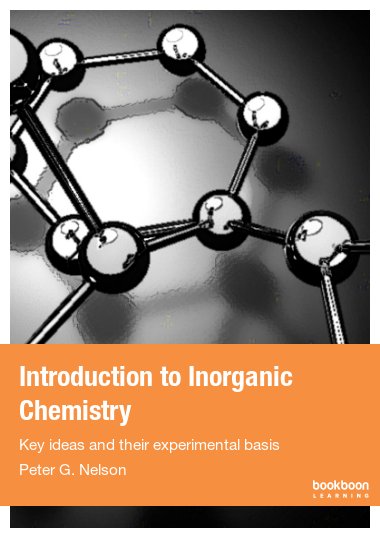The aim of the book is to introduce students to the basic ideas of inorganic chemistry and to show where they come from. It starts from chemical observations, and develops the ideas from these. It complements texts that start from the quantum theory of atoms and molecules and take a more physical approach.

الوصف
المحتوى
- Introduction
- Chemistry
- Inorganic Chemistry
- This course
- Broader context
- Further reading
- The relative importance of different elements
- The relative abundance of different elements
- The relative consumption of different elements
- Elements sought after from very low-grade ores
- Further reading
- Classification of elements into metals and nonmetals
- Types of element
- Assignment of elements to classes
- Volatilities of metals and nonmetals
- Chemical properties of metals and nonmetals
- Binary compounds
- General classification of compounds
- Limiting types of binary compound
- Metallic compounds
- Nonmetallic compounds
- Salt-like compounds
- Intermediate types of binary compound
- Further reading
- On the nature of the limiting types of binary compound
- Nonmetallic compounds
- Salt-like compounds
- Metallic compounds
- Limiting types of chemical bond
- Further reading
- Types of formula
- Empirical formulae
- Molecular formulae
- Structural formulae
- Geometrical formulae
- Classification of elements according to the electrochemical series
- Electrical and chemical series
- The electrochemical series
- Electronegativity
- Polar numbers
- Nomenclature of binary compounds
- Further reading
- Valency
- Ordinary valency
- Electrovalency
- Covalency
- Applicability of the three kinds of valency (V, E, and C)
- Extension
- Table: Principal valencies of some important elements
- Further reading
- Pseudo-binary compounds
- Introduction
- On the nature of pseudo-binary compounds
- Some important radicals
- Nomenclature
- The Periodic Table
- The Periodic Law
- Nomenclature
- Use of the table
- General features
- A better form of table
- Interpretation of main-group valencies in terms of a simple model of main-group atoms
- Basic theory
- Refinement of model in the light of the quantum theory of atoms
- The dative bond
- Isoelectronic principle
- Transition elements
- Shapes of molecules
- Further reading
- Compounds of higher order than two
- Limiting types
- Metallic compounds
- Nonmetallic and salt-like compounds
- Coordination compounds
- Basic theory
- Terminology of coordination compounds
- Nomenclature of coordination compounds
- Bonding in coordination compounds
- Nonclassical coordination compounds
- Further reading
- Loose compounds and solutions
- Solutions
- Loose compounds
- Types of chemical reaction
- General types
- Some special types of reaction
- Acids, bases, and salts
- Classical conception
- Stoicheiometric conception
- Electrolytic conception
- Equations for acid-base reactions
- Further aspects
- Lowry-Brønsted conception of acids and bases
- Solvent-system conception of acids and bases
- Other conceptions of acids and bases
- Oxidation and reduction
- Basic theory
- Half equations
- On the balancing of equations for redox reactions
- Further study
- Appendix 1 Hints and answers
- A1.1 Answers to questions and exercises, Chapters 1 - 5
- A1.2 Hints for exercises, Section 5.2
- A1.3 Answers to questions and exercises, Chapters 6 - 9
- A1.4 Answers to questions and exercises, Chapters 10 - 12
- A1.5 Answers to questions and exercises, Chapters 13 - 18
- Appendix 2 Pictures of structures
- Appendix 3
- Appendix 4
- Appendix 5